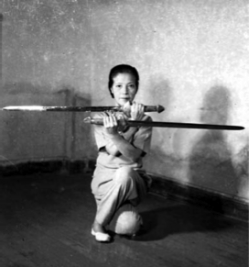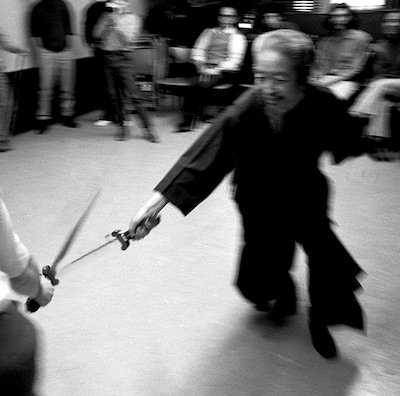 Today’s calligraphy 劍 shows a sword – or, as you may detect in the details, a two-edged, pointed blade. The sword is commonly seen as the queen of weapons. Furthermore, it also has a symbolic meaning. Like in Europe, swords as insignia of power (sometimes lended by the ruler to someone else) were also known in China. The sword thus became a symbol for the display of (male) power and of the authority of the state itself.
Today’s calligraphy 劍 shows a sword – or, as you may detect in the details, a two-edged, pointed blade. The sword is commonly seen as the queen of weapons. Furthermore, it also has a symbolic meaning. Like in Europe, swords as insignia of power (sometimes lended by the ruler to someone else) were also known in China. The sword thus became a symbol for the display of (male) power and of the authority of the state itself.
Sword fairies as Masters
 In contrast to that, the mystical folk tales of „old“ China often associate women with the sword and the sword play. Some of the most famous sword dancers were women and the creatures hidden in the woods, from whom wandering sword warriors could learn their exceptional skills, were known as sword fairies. That these were female and lived in the woods, may be interpreted as a hint: In learning the art of the sword, raw (male) physical power and learning by reflection (monastic seclusion on a mountain) is not the preferred way, but instead a passive reactive approach, which can solely be learned in fighting practice. The wood with its many trees is thus a symbol for the many warriors one needs to encounter before one’s own sword art will sufficiently develop.
In contrast to that, the mystical folk tales of „old“ China often associate women with the sword and the sword play. Some of the most famous sword dancers were women and the creatures hidden in the woods, from whom wandering sword warriors could learn their exceptional skills, were known as sword fairies. That these were female and lived in the woods, may be interpreted as a hint: In learning the art of the sword, raw (male) physical power and learning by reflection (monastic seclusion on a mountain) is not the preferred way, but instead a passive reactive approach, which can solely be learned in fighting practice. The wood with its many trees is thus a symbol for the many warriors one needs to encounter before one’s own sword art will sufficiently develop.
The way of the sword
The learning of the art of the sword is portrayed by the myths as a long path, which necessarily is accompanied by mutual cooperation. Facing the razor-like blade, only one mistake by the student would suffice to send him or her from life to death. The already small group of aspirants would be reduced to dust in no time. – How could an art flourish and develop under those circumstances?






